|
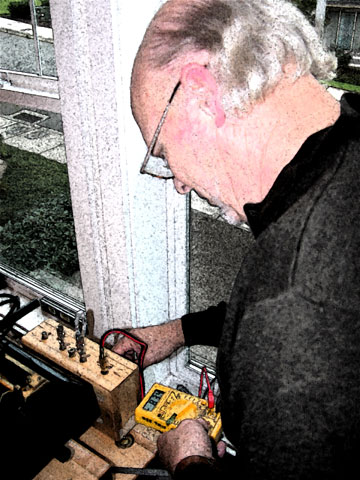
After the stylus was dialed in, Lloyd went to
work calibrating the phono amp with a Digital Multi-Meter (DMM). The DMM, which
comes with the Reference Phono Amp, is plugged into the output jack and allows a
user to find the null point with real precision. Lloyd and Fred didn't even have
to listen to the phono amp; all they had to do was monitor the DMM, which they
did at a distance of three to four feet, to minimize the proximity effect. If
the phono amp is picking up significant radio frequency (RF) signals, it will
show up here; they are looking for a stable "0" reading at the marked scale of
the DMM. Given the highly "naked" nature of the Proscenium signal path, it is
vulnerable to outside interference.
As it turns out, we were picking up a lot
of RF, due to the fact that my listening room is on a major hillside at an
elevation of 650'—which means that our line of sight to just about every RF
source is superb. This is great for radio, TV and HDTV broadcast reception;
rotten for bare silver wire and highly sensitive phono amps like the Walker
Reference. Fortunately, Lloyd and Fred had the answer for this problem, as
you'll see.
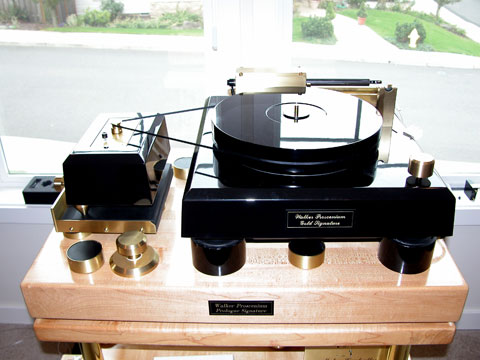
The completed installation—looks great, but
what to do about that RF in the phono section?
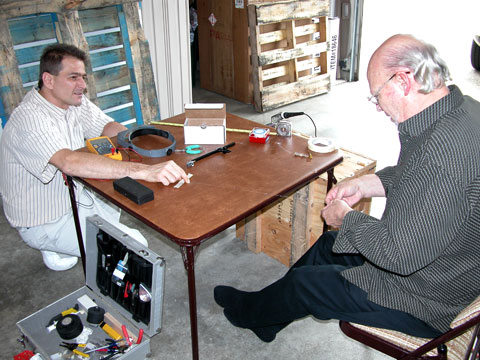
Fred and Lloyd went back down to the garage with
the tonearm, and proceeded to re-build the bare silver tonearm wire. What they
did was to create two twisted pairs of phono cables by wrapping them by hand.
The principle is the same one used in telephone cables (CAT1-3) and unshielded
twisted pair (UTP) Ethernet cables (CAT5/CAT5e/CAT6): by twisting pairs in an
unshielded line, you attenuate outside interference by creating a local magnetic
field powered by the signal current. Result: your signal passes, outside RF
bounces.
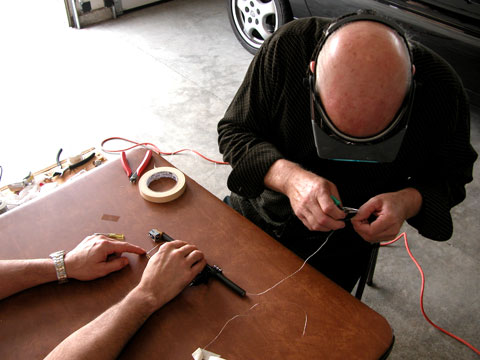
Here Lloyd prepares to finish the far end of one
of the new twisted phono leads; Fred holds the tonearm and the MC end of the
cable in place while Dr. Lloyd performs delicate surgery.
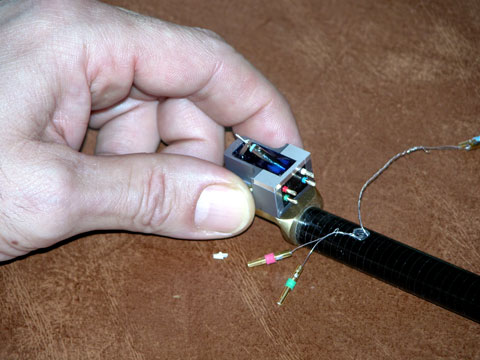
Having completed the new twisted pairs, Lloyd
prepares to attach the leads to the Magic Diamond cartridge. You can see the
access hole for the cables on the bottom side of the Proscenium carbon fiber
tonearm.
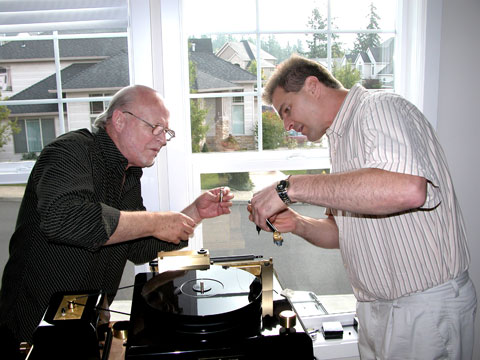
Having completed the re-wire, Lloyd and Fred
re-installed the tonearm on the Proscenium for re-testing and calibration of the
phono amp.
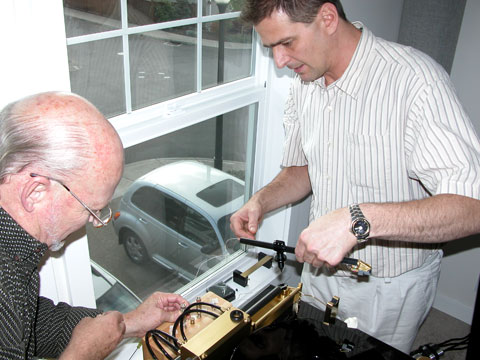
Lloyd re-connecting the phono leads and preparing
to attach the ground wires, while Fred holds the tonearm in place above the
damping trough.
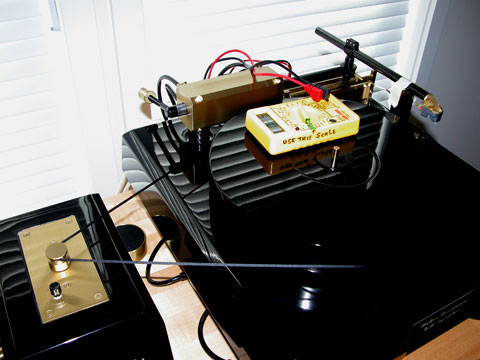
Lloyd and Fred re-checked the re-wired phono
leads and the phono amp one more time, just to be sure that we were getting a
proper null and correct calibration. Lloyd is out of the picture to the right,
reading the DMM display from a distance to avoid any proximity effect.
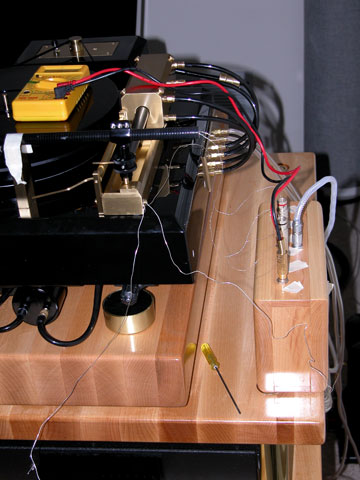
A side view of the Proscenium turntable, the
clear gap between the Prologue Shelf and the Prologue Rack, the leads, the
grounding array (all silver wire), and the DMM in place. The yellow-handled hex
driver is the VTA adjustment tool.
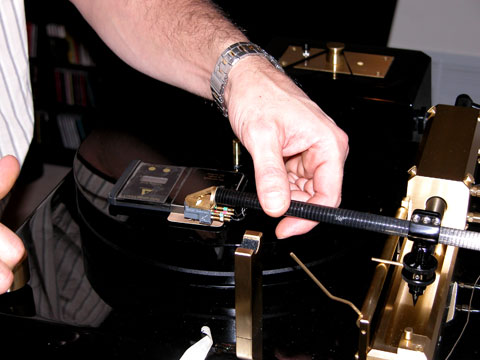
In this photograph, Fred is checking the tracking
force with a digital stylus scale borrowed from Jennifer Crock of JENA Labs. The
tracking force adjustment is found on the far end of the guide bar, and is
easily altered for the smallest increments. You can see the cueing bar in this
image, and also the damping pin under the guide bar.
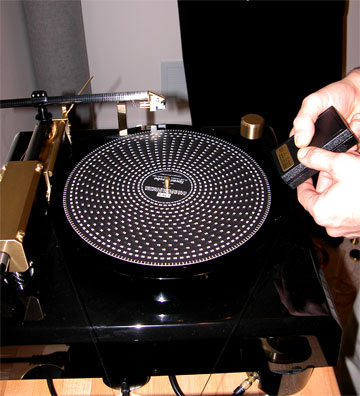
The next step was to make sure that the turntable
speed setting was spot-on. The Proscenium system also comes with a KAB
Electro-Acoustics strobe disc and strobe light, and a set of instructions for
using it. With this handy-dandy system, Fred was able to adjust the Walker Audio
Ultimate Motor Controller until the speed was calibrated for both 33 and 45 RPM.
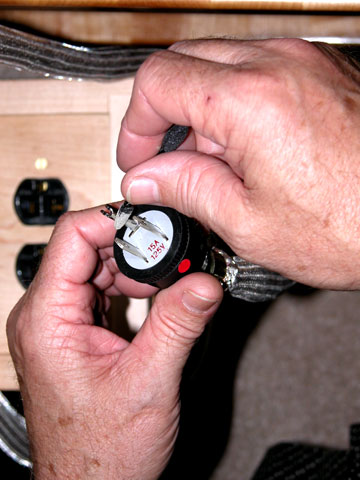
Meanwhile, back at the ranch, Lloyd was applying
Walker Audio's Extreme Super Silver Treatment (E-SST) to the pins of the Omega
Mikro Active power cords. Here we see proper technique for applying E-SST: you
put it on SPARINGLY, razor thin, and NOT GOBBED ON WITH A SHOVEL.
Enough said.
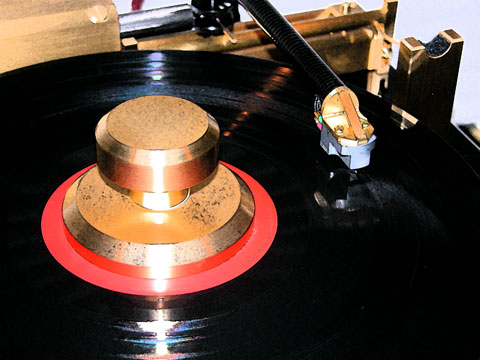
Yet another "at last!" moment: firing up the
Magic Diamond for the first time!
It was finally time to try the whole thing. Lloyd
added some synthetic oil to the damping trough, and did some preliminary
adjustments of the oil level on the damping ping. An initial trial VTA was set,
and the Proscenium's coated brass record clamp came down over my 180 gram
pressing of Scheherazade on Classic Records reissue of the LSC. Lloyd
used a carbon fiber brush (supplied with the Proscenium) on the LP, and then
lightly brushed the record clamp and the tonearm to neutralize any static build
up. This was a dry run…no serious listening yet…but the air pump, motor drive,
and all mechanical parts were working correctly, right out of the box.
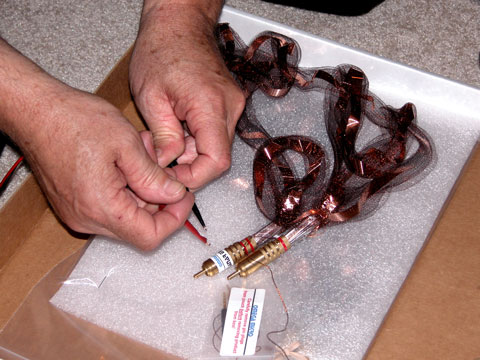
Now that they knew the Proscenium was
operational, Lloyd and Fred turned to completing the cabling of the rest of the
playback system. In this image Lloyd is testing the Omega Mikro Active ribbon
interconnects for continuity. The copper battery pack leads that supply 18 Volts
to the sheathing are visible at the bottom center of the photograph.
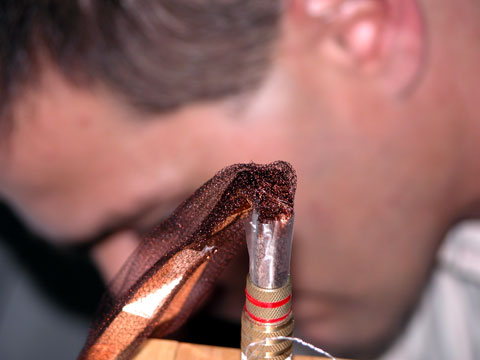
Here you can see a close-up of the Omega Mikro's
ribbon and sheathing protector at the RCA end attached to the output of the
Walker Audio Reference Phono Amp. The Omega Mikro cables require very careful
handling, but produce spectacular results. You won't be able to have pets,
children, or clumsy friends in your listening room if you have the Omega's in
place—but you will hear the most transparent, crystalline sound that
your system will produce. The Omega Mikro cables and power cords knocked me out
completely. If you can provide the care and environment they require, you'll be
re-paid many times over in audio revelations.
If you can't, though, then you should find
something more robust…the Omega Mikro's are definitely not for the
faint-of-heart, or the bumptious of household. Lloyd Walker recommends the
Silent Source power cords, interconnects and speaker cables as excellent
alternatives.
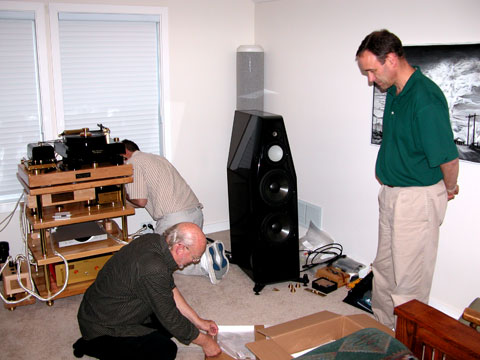
Towards the end of the setup session, PFO's
Mike Lavigne dropped in from Seattle. The owner of a Rockport System III Sirius
(the big guy) turntable, Mike has an abiding interest in fine turntables and
analog playback, though he also enjoys his EMM Labs CDSD/DAC6 SACD front end.
(For a profile of his listening room, see Mike's photo essay in PFO Issue
16 at
https://positive-feedback.com/Issue16/lavigneroom.htm.) Mike followed the
final stages of cabling and configuration with close attention.
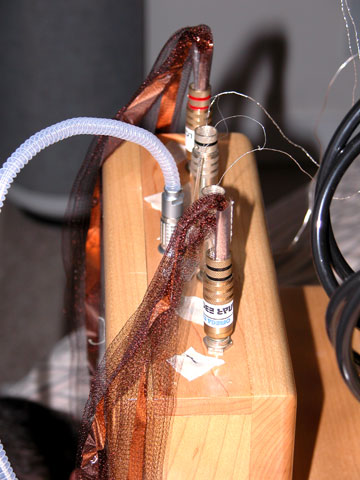
Here's the Walker Audio Reference Phono Amp with
the wiring complete, the grounding in, and the Omega Mikro Active output
interconnects in place. These were run to the inputs of the Linn Klimax
reference stereo line preamp two shelves down. From there, it went to the
darTZeel NHB-108, then on to the Kharma Grande Ceramiques. Our initial quickie
trials indicated that the playback chain was operational …we could heat things up
now.
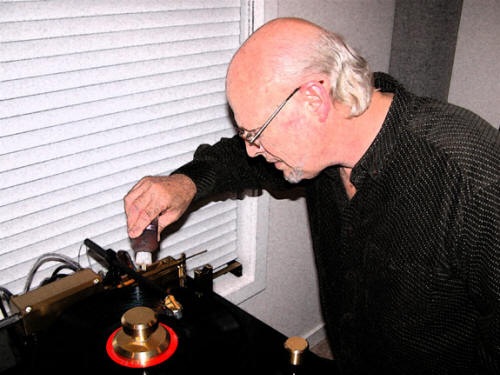
Maestro Lloyd adds some synthetic motor oil to
the damping trough, getting its level just right before doing some listening
with members of the PFO group. Lloyd uses synthetic oil because it does a
fine job of knocking down vibrations, is easy to obtain, and doesn't have the
smell that standard oils have. I checked this carefully …unless I put my nose
within an inch or two, I can't smell the stuff at all. And boy, does the
Proscenium's damping system work.

While members of the PFO group arrived
(Rick Gardner, Jennifer Crock, Michael Crock, and Mike Lavigne), Lloyd finished
dialing in damping. You can tell what a tough crowd this is—check out the
smile on Lloyd's face!
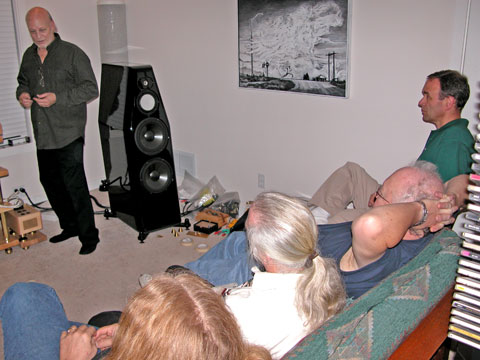
Lloyd gave an overview of his turntable system to
(left to right) Jennifer Crock, Michael Crock, Rick Gardner and Mike Lavigne.
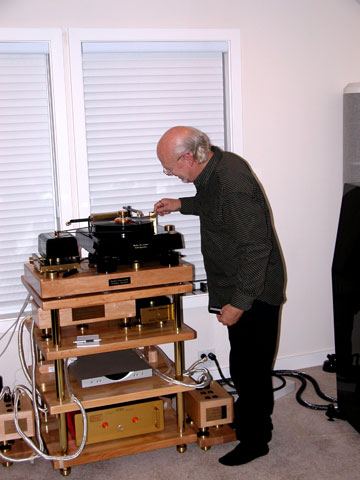
Having completed the introduction, Lloyd queued
up an LP. Into the groove went the Magic Diamond; out of the groove came—MAGIC. (See Rick Gardner's quick retrospective sidebar about this section
elsewhere in this issue.) You have to remember that the Proscenium was brand
spanking new and without any serious break-in. You've seen the assembly in this
photo essay; the major work was all done within 24 hours. And here we were,
listening to the results at the end of the same day that assembly had begun. All
of us were various shades of amazed and pleased at the very first results from
the Proscenium system. We played some classical (RCA Living Stereo reissues via
Classic Records), and some rock (e.g., the Japanese pressing of Led Zeppelin
II, and the Classic Records 180 gram 33.3 RPM of David Crosby's If I
Could Only Remember My Name …the song "Laughing.") Side one of this album is
a particular favorite for both Rick Gardner and me; the music is truly haunting.
I'll never forget the look on Rick's face when "Laughing"
finished, and we got ready to go to dinner. He sat there for a moment, then
stood up, shuddered, looked at me and said, "Unquestionably
the finest sound that I've heard in your system."
Coming from Rick, this is saying quite a lot. And
frankly, I'd agree.
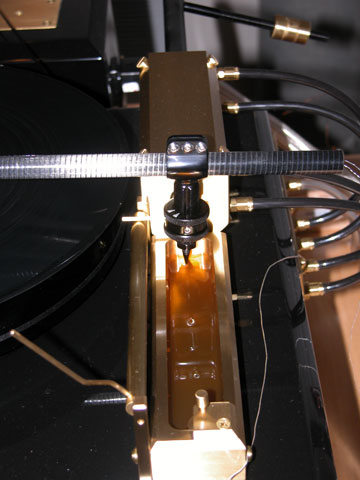
Another look at the damping trough after it
settled in; the wire is a naked silver grounding strap.
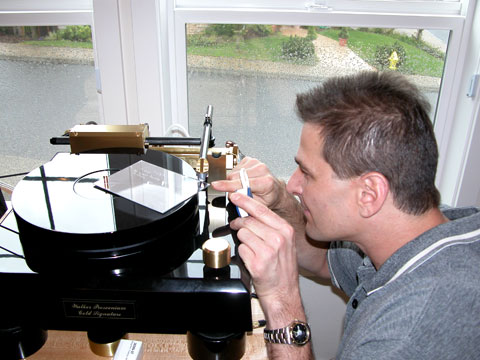
The following morning, Fred and Lloyd checked the
Proscenium again for any signs of settling or drift. (They didn't expect to see
any.) All was well. In this image, Fred is assessing the stylus alignment one
last time.
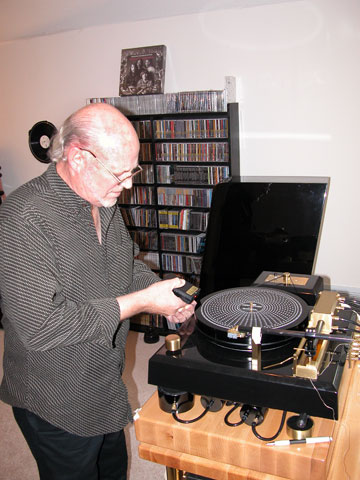
Lloyd does a final KAB calibration strobe check
of the turntable speed.
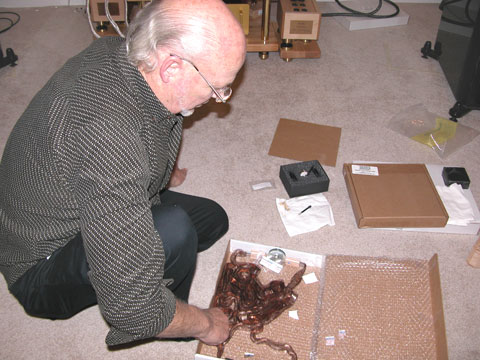
Lloyd packs up the leftover parts and pieces.
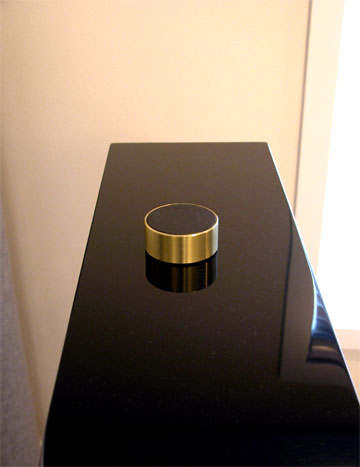
Valid Points tuning discs were even carefully
placed on the Kharma Grande Ceramiques.
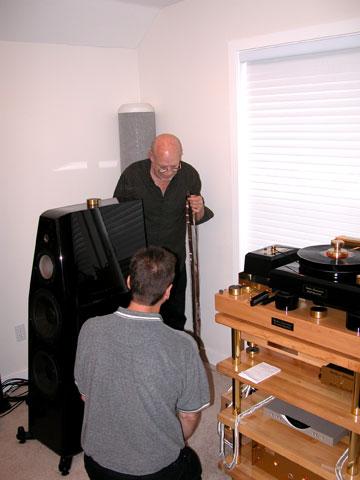
Lloyd and Fred doing final layout and tape-down
of the Omega Mikro Active speaker cables.
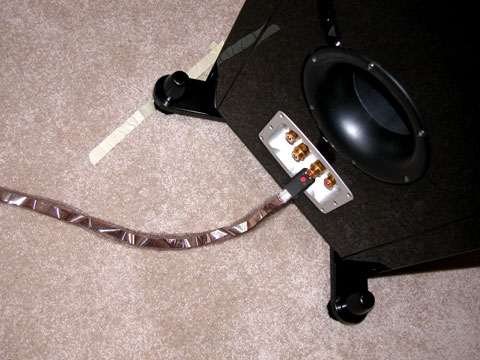
Attaching the Omega Mikro Active speaker cables
to the Kharma.
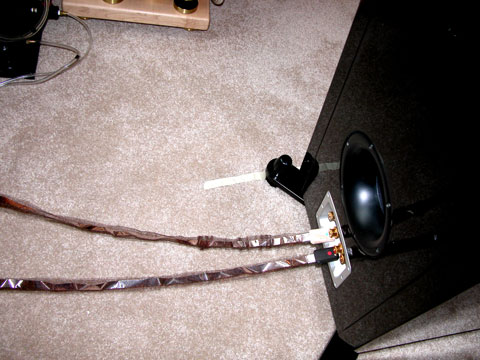
One set complete; after this, Fred and Lloyd
worked to elevate all cables off the carpeting, to avoid dielectric effects.
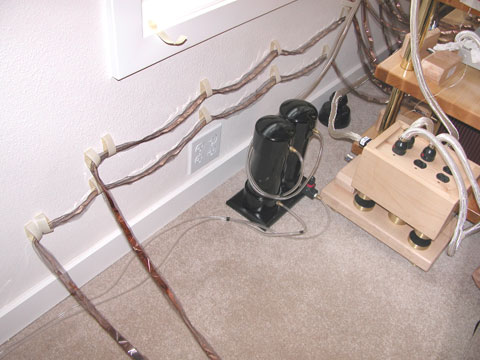
Left channel tape-down. Lloyd and Fred are
thorough in every phase of their work. "The devil's in the details," says the
Lloydmeister—I don't think you can argue with the sonic results.
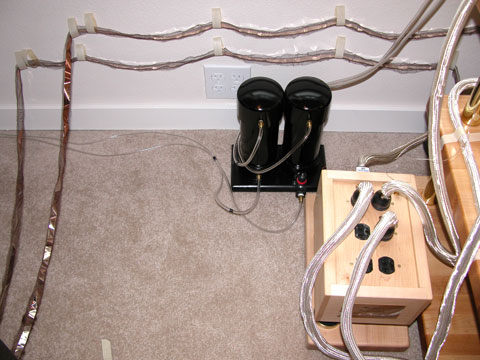
Another look at the left channel area, showing
the neat array of cords, cables, tubes, and stands. Pleasing to the eye, but
even more pleasing to the ear.
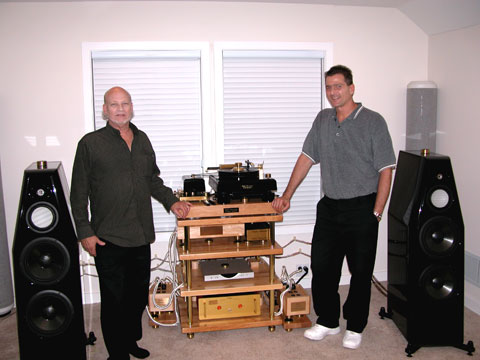
Job done! Lloyd and Fred enjoy the moment of
completing the Proscenium Gold Signature system setup; they had to take off
early the next day.
IMPORTANT NOTE: the purchase of a Walker Audio
Proscenium system now includes the cost of Lloyd Walker and Fred Law personally
setting up and optimizing the system, as they did for me.
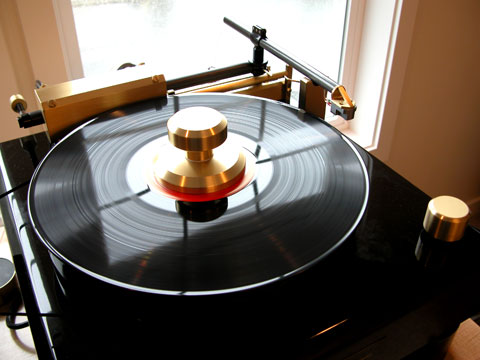
The beauty of the Proscenium as a work of art is
undeniable…
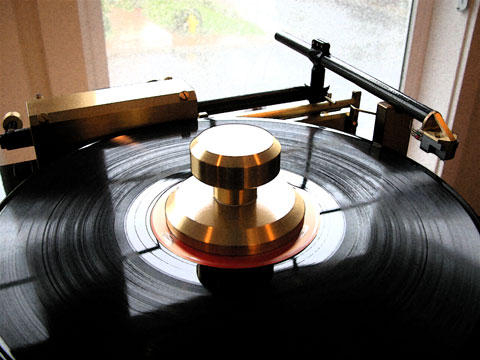
…and there is no doubt in my mind that you are
looking at a pinnacle of the audio arts.
Page 5
Extended notes on the Proscenium Gold Signature
system
|


































